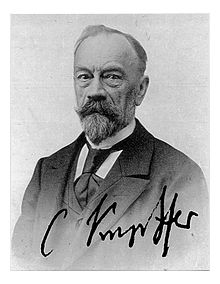Karl Wilhelm von Kupffer
Karl Wilhelm von Kupffer | |
|---|---|
 | |
| Born | Karl Wilhelm Kupffer 14 November [O.S. 2] 1829 Lesten, Kreis Tuckum, Courland Governorate, Russian Empire (present-day Lestene, Tukums municipality, Latvia) |
| Died | 16 December 1902 (aged 73) |
| Nationality | Baltic German |
| Alma mater | Imperial University of Dorpat |
| Scientific career | |
| Fields | physiology and anatomy |
| Institutions | Christian Albrecht University of Kiel Albert University of Königsberg |
| Doctoral advisor | Emil Du Bois-Reymond Johannes Peter Müller Friedrich Bidder |
Karl Wilhelm Ritter[1] von Kupffer (born Karl Wilhelm Kupffer; 14 November [O.S. 2] 1829 – 16 December 1902) was a Baltic German anatomist who discovered stellate macrophage cells that bear his name.
Academic career
He was the eldest son of pastor Karl Hermann Kupffer (1797–1860). In 1854, he obtained his medical doctorate from the University of Dorpat, where shortly afterwards he served as an assistant to Friedrich Heinrich Bidder (1810–1894). In 1856–1857 he took a scientific journey to Vienna, Berlin and Göttingen, an extended trip in which he studied physiology with Emil Du Bois-Reymond (1818–1896) and Johannes Peter Müller (1801–1858). Afterwards, he returned to Dorpat, where he later became an associate professor.
In 1866 he was appointed chair of anatomy at the University of Kiel, and several years later relocated to Königsberg (1875) as a professor of anatomy. From 1880 until his retirement in 1901, Kupffer held the chair of anatomy at the University of Munich.
Scientific research
Kupffer is largely known for his work in the fields of neuroanatomy and embryology. He conducted studies on the development of the brain, spleen, pancreas and kidneys, also performing research involving innervation of exocrine gland and doing investigations on early differentiation of mesoderm. While Bidder's assistant at Dorpat, he studied structures of the central nervous system, and during his tenure at Königsberg, he had the opportunity to examine the cranium of philosopher Immanuel Kant.[2]
In regards to his discovery of "Kupffer cells" in 1876, he initially suggested that this type of cell belonged to a group of perivascular cells (pericytes) of the connective tissues or to the adventitial cells. Two decades later (1898), he revised his earlier analysis, stating that the cells form an essential component of the vascular walls and correlate to the specific cells of endothelium, capable of phagocytising foreign materials.[3] Shortly afterwards, pathologist Tadeusz Browicz (1847-1928) from Jagellonian University in Kraków, correctly identified them as macrophages.
Selected works
- De medullae spinalis textura in ranis ratione imprimis habita indolis substantiae cinerae, 1854
- Der Schädel von Immanuel Kant, Archiv für Anthropologie, Band 13
- Über Sternzellen in der Leber, brief an Prof. Waldyer, 1876, Archiv, Mikroskopische Anatomie, 12, 352–358
- (with Berthold Benecke): Photogramme zur Ontogenie der Vogel, etc. 1879.
- Über die sogennanten Sternzellen der Säugethierleber, Archiv, Mikroskopische Anatomie, 1899, 54, 254–288
- Über Sternzellen der Leber, Versammlung 1898, Veröffentlicht 1898, anatomische Geselschaft.
See also
References
- This article contains information based on a translation of an equivalent article at the German Wikipedia.
- Porträt, Mit (1903). "Karl v. Kupffer". Archiv für Mikroskopische Anatomie. 62: 669–718. doi:10.1007/BF02985556. S2CID 88453516.
- ^ Regarding personal names: Ritter is a title, translated approximately as Sir (denoting a Knight), not a first or middle name. There is no equivalent female form.
- ^ Wake, Kenjiro (2004). "Karl Wilhelm Kupffer And His Contributions To Modern Hepatology". Comparative Hepatology. 3 (Suppl 1): S2. doi:10.1186/1476-5926-2-S1-S2. PMC 2410225. PMID 14960154.
- ^ The Global and the Local: The History of Science and the Cultural Integration of Europe. Proceedings of the 2nd ICESHS (Cracow, Poland, September 6–9, 2006) / Ed. by M. Kokowski, Browicz or Kupffer cells?
- Articles with short description
- Short description is different from Wikidata
- Articles with hCards
- Articles with FAST identifiers
- Articles with ISNI identifiers
- Articles with VIAF identifiers
- Articles with BIBSYS identifiers
- Articles with GND identifiers
- Articles with LCCN identifiers
- Articles with NKC identifiers
- Articles with NTA identifiers
- Articles with PLWABN identifiers
- Articles with Leopoldina identifiers
- Articles with DTBIO identifiers
- Articles with SNAC-ID identifiers
- Articles with SUDOC identifiers
- 1829 births
- 1902 deaths
- People from Tukums Municipality
- People from Courland Governorate
- Baltic-German people from the Russian Empire
- Emigrants from the Russian Empire
- German biochemists
- German anatomists
- German histologists
- German embryologists
- German curators
- Academic staff of the Ludwig Maximilian University of Munich
- Academic staff of the University of Kiel
- Academic staff of the University of Königsberg